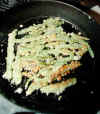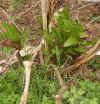| 04-26-04
The hunting for little gray and black morels has been something less
than spectacular this year in Hoosierland, but recent rains have kindled
hope for a big bloom of "big yallers," the king of morels.
It that's not enough to whet the appetite of natural-food foragers,
the fields, woodlands, lawns of the land, and other areas are exploding
with a great variety of edible plants that can be used in many ways.
Let's just say, for example, that you have been having rotten luck with
the morels and you yearn for something that comes from the heart of the
land. It is likely that you have walked past dozens of great items of natural
food in your quest for the lordly morel.
Although the veggie bins of large grocery stores are stocked with many
species of commercially-produced plants for tasty dishes of greens, my
thoughts of these spring delights hark back to the days when my mother
and grandmother donned sunbonnets and sallied forth with scissors or butcher
knives to fill their apron with the tender leaves of dandelion, curly dock,
plantain, lambs' quarters, and a variety of other plants.
Although many of the plants that are producing young, tender shoots
now can best be combined to make a dish of greens (cooked with a smoked
ham hock or some other seasoning bone), a pair of notable exceptions stand
alone very well. They are pokeweed and stinging nettle.
Although pokeweed is best known historically for its fall crop of blue
berries (said to be an important source of ink), and the stinging nettle,
best known for the itchy skin it creates on humans, both can be turned
into tasty, nutritious dishes.
Pokeweed shoots, known in Southern Indiana as "the poor man's morels,"
are now pushing their way up through the earth in the central part of the
state. This means they are four to six inches tall now in the southern
third of the state, and starting to emerge in the north.
It is best to harvest poke shoots when they are four to six inches tall
if they are to be fried, a la morel. With a sharp knife, I simply lop them
off at ground level. This, incidentally, will cause no damage to the root
system of the plants; they will continue to grow.
I wash the shoots in cold running water at the kitchen sink and pinch
off any loose leaves that are starting to unfold. I parboil the shoots
in salted water and drain them when they are starting to show some tenderness.
This does not take long. Tender leaves pinched off the shoots can be combined
with other greens or they will stand as a greens dish on their own.
When shoots are drained and cool, I split them lengthwise on cutting
board, dip them in a mixture of egg and milk (just as I prepare morels),
dredge them in a 50-50 mixture of finely-rolled Keebler "Club" crackers
and flour, and fry them in olive oil (or a mix of bacon fryings and olive
oil) to a golden brown on all sides. This requires almost constant attention
to avoid burning and patting them down with a spatula or turner to make
sure each shoot is well cooked.
I like scissors for harvesting the tender top leaves of stinging nettle,
and it is a good idea to wear thin plastic gloves to avoid the itchy sensation
this plant can cause. The short, hair-like surface of the stems (the cause
of the itching sensation) will disappear when the leaves are cooked.
I prepare stinging nettle leaves just as I would cook spinach or any
other green plant--just enough salted water to cover the leaves . . . with
a seasoning bone (with some meat). When cooked, stinging nettle leaves
taste much like spinach.
In cooking wild greens I change the water once or twice to lessen the
influence of any toxic qualities the plants might have.
Although wild greens alone are tasty, they can be effectively combined
with chopped or green onion (even wild onions), mushrooms, and new potatoes
and creamed.
Click
on thumbnail photo for enlarged view.
 |
 |
| Poke--I
fry poke in an iron skillet with olive oil, turning it occasionally to
brown all sides. |
Stalks--Last
year's old growth (light stalks) will locate new growth (green leaves). |
|

